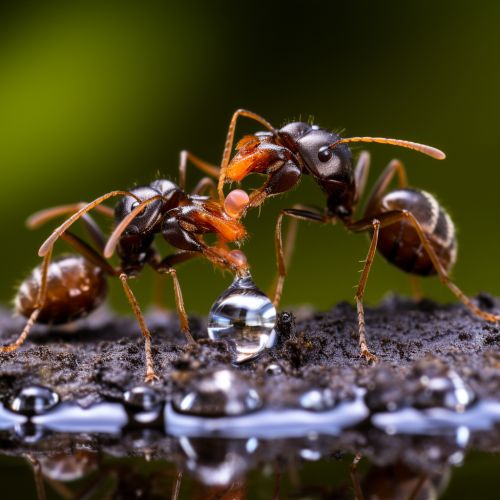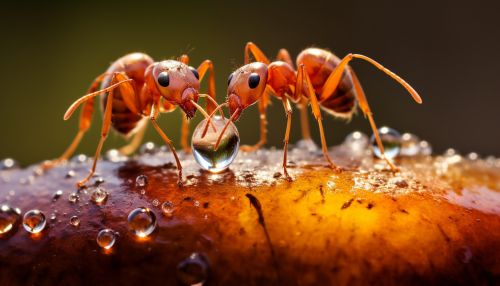Trophallaxis
Introduction
Trophallaxis is a form of reciprocal social behavior observed in certain animal species, particularly insects, where food or other substances are transferred among colony members. This process is crucial for the survival and success of social insect colonies, such as ants, bees, and termites, as it facilitates resource sharing, communication, and disease resistance within the colony. Trophallaxis can occur either mouth-to-mouth (stomodeal) or anus-to-mouth (proctodeal), depending on the species and the substance being transferred.


Behavior and Mechanism
Trophallaxis is more than just a method of food sharing; it is a complex behavior that plays multiple roles in the colony's life. The act of trophallaxis involves one individual (the donor) regurgitating a liquid substance into the mouth of another individual (the recipient). This behavior is not limited to adults feeding larvae; it also occurs among adult individuals. The substance transferred can be food, but it can also contain other elements like pheromones or microbes, which can influence the behavior and health of the recipient.
In stomodeal trophallaxis, the substance is transferred mouth-to-mouth. This is commonly observed in ants and bees. In proctodeal trophallaxis, the substance is transferred from the anus of the donor to the mouth of the recipient. This is typical in termites, where the gut microbiota necessary for cellulose digestion is shared among colony members.
Role in Social Insects
Food Sharing
Trophallaxis is a primary method of food distribution within a colony. Forager ants, bees, or termites collect food and bring it back to the nest, where it is shared with other colony members through trophallaxis. This ensures that all members, including those who cannot forage, such as the queen, larvae, and nest workers, receive adequate nutrition.
Communication
Trophallaxis also serves as a means of communication within the colony. The exchanged fluid often contains chemical signals that can convey various types of information, such as the location of a food source, the presence of a threat, or the reproductive status of the queen. This chemical communication helps coordinate the activities of the colony and maintain its social structure.
Disease Resistance
Trophallaxis can contribute to the colony's disease resistance. The shared fluid may contain beneficial microbes that help protect against pathogens. Some ants have been observed to engage in "medicinal" trophallaxis, where they share substances with antimicrobial properties to help control disease outbreaks within the colony.
Evolutionary Significance
Trophallaxis is thought to have played a significant role in the evolution of social insects. By facilitating resource sharing and communication, it has enabled these species to form complex societies with division of labor and cooperative behavior. Some researchers suggest that trophallaxis may have even influenced the evolution of certain physical traits in social insects, such as the development of specialized mouthparts for liquid food transfer.
Criticisms and Controversies
Despite its apparent benefits, trophallaxis is not without controversy. Some scientists argue that the risks of disease transmission outweigh the benefits of resource sharing and communication. Others question the extent to which trophallaxis contributes to social cohesion, suggesting that other factors, such as genetic relatedness or environmental conditions, may be more important.
